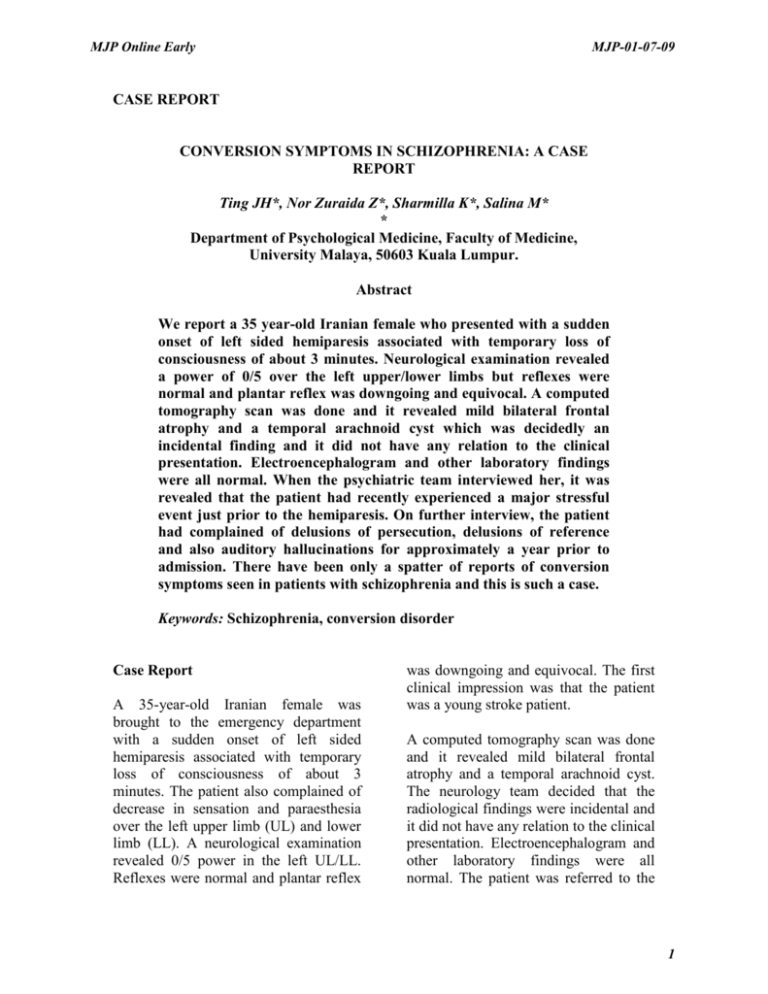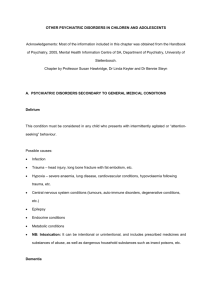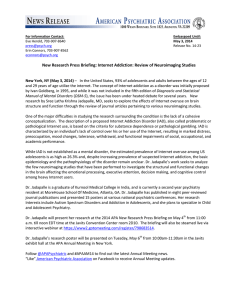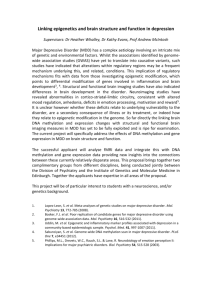Conversion symptoms in schizophrenia
advertisement

MJP Online Early MJP-01-07-09 CASE REPORT CONVERSION SYMPTOMS IN SCHIZOPHRENIA: A CASE REPORT Ting JH*, Nor Zuraida Z*, Sharmilla K*, Salina M* * Department of Psychological Medicine, Faculty of Medicine, University Malaya, 50603 Kuala Lumpur. Abstract We report a 35 year-old Iranian female who presented with a sudden onset of left sided hemiparesis associated with temporary loss of consciousness of about 3 minutes. Neurological examination revealed a power of 0/5 over the left upper/lower limbs but reflexes were normal and plantar reflex was downgoing and equivocal. A computed tomography scan was done and it revealed mild bilateral frontal atrophy and a temporal arachnoid cyst which was decidedly an incidental finding and it did not have any relation to the clinical presentation. Electroencephalogram and other laboratory findings were all normal. When the psychiatric team interviewed her, it was revealed that the patient had recently experienced a major stressful event just prior to the hemiparesis. On further interview, the patient had complained of delusions of persecution, delusions of reference and also auditory hallucinations for approximately a year prior to admission. There have been only a spatter of reports of conversion symptoms seen in patients with schizophrenia and this is such a case. Keywords: Schizophrenia, conversion disorder Case Report A 35-year-old Iranian female was brought to the emergency department with a sudden onset of left sided hemiparesis associated with temporary loss of consciousness of about 3 minutes. The patient also complained of decrease in sensation and paraesthesia over the left upper limb (UL) and lower limb (LL). A neurological examination revealed 0/5 power in the left UL/LL. Reflexes were normal and plantar reflex was downgoing and equivocal. The first clinical impression was that the patient was a young stroke patient. A computed tomography scan was done and it revealed mild bilateral frontal atrophy and a temporal arachnoid cyst. The neurology team decided that the radiological findings were incidental and it did not have any relation to the clinical presentation. Electroencephalogram and other laboratory findings were all normal. The patient was referred to the 1 MJP Online Early consultation-liaison psychiatry team for an opinion as the neurology team felt that her symptoms were not consistent. When the psychiatric team interviewed her, it was revealed that the patient had recently experienced a major stressful event just prior to the hemiparesis. She was in a relationship and recently, her boyfriend of 7 months had asked to break up with her. On further interview, the patient had complained of delusions of persecution, delusions of reference and also auditory hallucinations for approximately a year prior to admission. The patient had been in Malaysia for 7 months to further her study. However, her symptoms of persecutory delusions had been there since she was in Iran. She had been telling her family members that people were following her and she appeared fearful. She was diagnosed to have Schizophrenia. When she finally managed to arrange and persuade to meet her boyfriend, the patient’s hemiparesis resolved immediately and was discharged the next day with no clinical sequelae. However, the auditory hallucinations and the persecutory delusions persisted. The patient was treated with Quetiapine 100mg daily increased daily to 400mg per day after 4 days. The psychotic symptoms improved after starting the patient on treatment. The patient subsequently went back to Tehran and she was advised to continue treatment there. Discussion Approximately 2,500 years ago, sage Greek philosophers and physicians of the great ancient Greek civilization came MJP-01-07-09 across a curious illness. They named it ‘hysteria’, which is derived from the belief that unexplainable losses of motor and special sensory function in women were caused by the wanderings of unanchored uteri to distant body parts, where they interfered with normal physiology1. Hysteria eventually became recognized and coined as ‘conversion disorder’, which has its origin in the underpinnings of Freud’s assumption that patients converted their psychological symptoms into physical or somatic ones. The interest in conversion disorder peaked at the turn of the 20th century, after which a steady decline of interest was observed, up to a point where the disease itself was thought to have waned2. However, over the past 10 years there has been a resurgence in research into conversion disorder. Conversion disorder has been established that it remains common, and disabling3. Interestingly, conversion disorder is a psychiatric diagnosis which rarely presents to psychiatrists first. Neurologists are invariably the first line of physicians to see these patients as the presenting complaint is typically a neurological symptom. The full diagnosis, however, requires an 4 ‘associated psychological factor’ which is where the expertise of the psychiatrists is sought. As conversion disorder has frequently been associated with a comorbid psychiatric or neurological diagnosis, care should be taken to explore other co-morbidities. Most literature finds that conversion disorder is associated with an anxiety disorder or phobia as well as mood disorders, and occasionally schizophrenia5. This report highlights the complexity of diagnosis 2 MJP Online Early and the uncommon occurrence of a clinical presentation where conversion symptoms are seen in the background of schizophrenia. The full diagnosis of conversion disorder usually requires both a psychiatrist and a neurologist, and therefore needs good collaboration between them in the multiple-step process: careful history taking and physical examination by the neurologist, referral to the psychiatrist, and finally, optimally, a clear joint explanation to the patient6. The diagnosis of conversion disorder relies on clues and signs such as inconsistency of symptoms, give-way weakness, ‘la belle indifference’ and the Hoover’s sign. However, these signs may not reliably exclude neurological disease7. A question that lingers amongst the therapists is how are the symptoms and signs produced, if they are not feigned? Electrophysiological, single-photon emission computed tomography and positron emission tomography studies suggested a central corticofugal inhibition of afferent stimuli as responsible for hysterical sensory loss, since evoked potentials showed abnormalities that disappeared when tested again after resolution of the symptoms8-10. In 2001, Vuilleumier and colleagues11 shed further light on central inhibitor mechanisms, involving not only cortical areas but also corticosubcortical circuits. These findings explain the possible biological etiology of conversion disorders. Conversion disorders have been frequently associated with other mental illnesses, mostly depression and anxiety disorders. Sar et al12 reported 50% anxiety, 42% phobia, 71% affective MJP-01-07-09 disorder and 34% depression among patients with conversion disorder. Slater and Glithero13 studied 85 patients with hysteria and followed up with them for 9 years. 39% of the patients had no significant organic disease while others received diagnoses such as schizophrenia and depression. Conversion symptoms has been reported in patients with schizophrenia although infrequently. Some authors have described it as a possible prodromal presentation of schizophrenia5. Cernovsky studied 112 patients with schizophrenia and hysterical symptoms were recorded in 37.5% of the patients14. Noble15 also observed 6 of his patients who presented with a mixture of hysterical and schizophrenic symptoms. Joubert reported that anxiety and hysterical symptoms have been described in schizophrenic populations and wondered if such symptoms represent discrete clinical entities or are intrinsic to the schizophrenic process16. In fact, hysteria seems to have a rather closely interrelated past with schizophrenia. Historically, ‘hysterical psychosis’ was used to describe a vast amount of posttraumatic psychopathology. In the 19th century, it was especially well-studied, particularly in French psychiatry. In the early 20th century the diagnosis of hysteria and hysterical psychosis fell into disuse. Patients formerly diagnosed as hysterical psychosis were later diagnosed as schizophrenics or malingerers17. If hallucinations occur in conversion disorder, it differs from those of psychotic disorders in the way that they generally occur with intact insight, involvement of more than one sensory 3 MJP Online Early modality, psychologically meaningful and described as an interesting story 4. In conclusion, conversion symptoms in patients with schizophrenia are not common but comorbidity has been documented. After all, psychiatry is a discipline where comorbidities are the general rule rather than exception. Therefore it is essential to tease out the comorbidities so as to best manage the patient and possible achieve the best outcome. References 1. Berek JS. Novak’s Textbook of Gynecology. Williams and Wilkins. Baltimore, Maryland 1996; 299. 2. Stefanis C, Markidis M, Christodoulou G. Observations on the evolution of the hysterical symptomatology. Br J Psychiatry 1976; 128:269–275. MJP-01-07-09 6. Aybek S, Kanaan RA, David AS. The neuropsychiatry of conversion disorder. Curr Opn in Psychiatry 2008; 21(3):275-280. 7. Ziv I, Djaldetti R, Zoldan Y, et al. Diagnosis of ‘nonorganic’ limb paresis by a novel objective motor assessment: the quantitative Hoover's test. J Neurol 1998; 245:797–802. 8. Levy R, Mushin J. The somatosensory evoked response in patients with hysterical anaesthesia. J Psychosom Res 1973; 17:81–84. 9. Tiihonen J, Kuikka J, Viinamaki H, et al. Altered cerebral blood flow during hysterical paresthesia. Biol Psychiatry 1995; 37:134–135. 10. Marshall JC, Halligan PW, Fink GR, et al. The functional anatomy of a hysterical paralysis. Cognition 1997; 64:1–8. 3. Stone J, Sharpe M, Rothwell PM, Warlow CP. The 12 year prognosis of unilateral functional weakness and sensory disturbance. J Neurol Neurosurg Psychiatry 2003; 74:591–596. 11. Vuilleumier P, Chicherio C, Assal F, et al. Functional neuroanatomical correlates of hysterical sensorimotor loss. Brain 2001; 124:1077–1090. 4. First MB, Williams JBW, Gibbon M et al: The structured clinical interview for DSM-IV axis I disordersclinical version. American Psychiatric Association, American Psychiatric Press, Washington. 1997; 452-7. 12. Sar V, Akyuz G, Kundakci T, et al. Childhood trauma, dissociation, and psychiatric comorbidity in patients with conversion disorder. Am J Psychiatry 2004; 161:2271–2276. 5. Kaplan HI, Sadock BJ. Synopsis of psychiatry:behavioral sciences & clinical psychiatry, 10th ed. Lippincott Williams and Wilkins. 2007; 638-642. 13. Slater ET, Glithero E. A follow up of patients diagnosed as suffering from ‘hysteria’. J Psychosom Res. 1965; 9:9-13. 4 MJP Online Early MJP-01-07-09 14. Cernovsky Z, Landmark J. Correlates of hysterical symptoms in schizophrenic patients. Psychological Reports. 1994; 75 (1): 251-5. 16. Joubert PM. Anxiety and hysterical symptoms in schizophrenia. S African Psychiatry Rev. 2002; 5(4): 914. 15. Noble D. Hysterical symptoms manifest in schizophrenic illness. Psychiatry XIV. 1951; 153-160. 17. van der Hart O, Witzum E, Friedman B. From hysterical psyhosis to reactive dissociative psychosis. J of Traumatic Stress. 1993; 6(1): 1-13. Corresponding author: Ting Joe Hang, Department of Psychological Medicine, Faculty of Medicine, University Malaya, 50603 Kuala Lumpur.……………………….. Email: joethting@gmail.com 5







